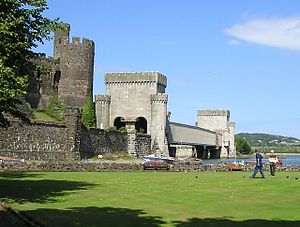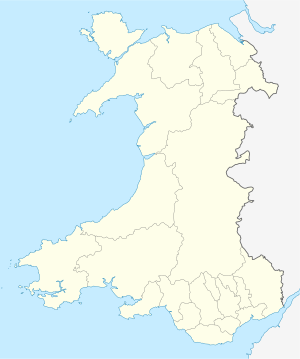Conwy Railway Bridge
Coordinates: 53 ° 16'49 " N , 3 ° 49'26" W.
| Conwy Railway Bridge | ||
|---|---|---|
| use | Railway bridge | |
| Crossing of | River Conwy | |
| place | Conwy | |
| construction | wrought iron box girder bridge | |
| Clear width | 122 m | |
| Clear height | 5.5 m above HW | |
| start of building | 1846 | |
| completion | 1848 | |
| planner | Robert Stephenson et al. a. | |
| location | ||
|
|
||
| on the right the Conwy Railway Bridge | ||
The Conwy Railway Bridge in Conwy on the north coast of Wales ( Great Britain ) is a railway bridge over the River Conwy on the North Wales Coast Line from Crewe via Chester , Conwy, Bangor and the Britannia Bridge to Holyhead on Anglesey , the connecting port for traffic to Dublin in Ireland . It was the first self-supporting, wrought-iron box girder bridge . The double-track bridge is still in use.
location
The Conwy Railway Bridge stands at a narrow part of the river, dominated by Conwy Castle , between the castle and a flat rock ridge jutting far into the river next to the Conwy Suspension Bridge, opened in 1826, and a road bridge from 1958. The railway bridge is oriented so that the tracks are immediately below run along the southern walls of the castle.
Between the railway bridge and the chain bridge there was at times a narrow suspension bridge for pedestrians, which can only be seen on old views.
description
The Conwy Railway Bridge, also Conway Tubular Bridge or Tubular Railway Bridge, consists of two parallel, wrought-iron hollow girders that are inserted into corresponding openings in the massive, rectangular towers at both ends. The towers with their battlements are based on the style of the castle, they have a floor plan of 19 × 9 meters. The trains run through the openings in the towers and through the hollow boxes as if through a tunnel. The bridge has a clear width of 122 m (400 ft ) and a clear height of 5.5 m (18 ft) above MHW . The hollow girders were self-supporting, but because of the heavier trains, inconspicuous steel supports were installed near the bank in 1899.
The box girders are attached to the towers on one side, on cast-iron rollers on the other side and mounted on balls by means of hanging rails. Each of the box girders weighs around 1,300 tons. They have a maximum thermal expansion of 2.54 cm (1 inch). They were originally painted light gray and provided with an arched roof made of galvanized corrugated iron.
history
The Conwy Railway Bridge, built between 1846 and 1848 and opened in 1849, is the only one of the wrought iron box girder bridges built by Robert Stephenson that still exists after the Britannia Bridge, completed in 1850, was destroyed by fire in 1970 and replaced by an arch bridge, and the Pont, completed in 1859 Victoria in Montreal in Canada was replaced by a steel truss bridge in 1898.
The Conwy Railway Bridge, like the much larger Britannia Bridge, was planned by Robert Stephenson for the Chester and Holyhead Railway , founded in 1844 . He took advice from William Fairbairn and Eaton Hodgkinson . In agreement with the client, models were made, numerous experiments and investigations with round, elliptical and rectangular cross-sections were carried out and various solutions of various details were discussed. The shape of a rectangular hollow box finally chosen for the Britannia Bridge was also used for the Conwy Bridge, so that both bridges, apart from their size, were largely identical. The experience gained during the construction of the smaller Conwy Railway Bridge could be used in the Britannia Bridge immediately following.
The architect of the two towers was F. Thompson (1803–1895). Since Hodgkinson was of the opinion that the load of the long box girders must also be carried by chains like chain bridges, Stephenson wanted to leave the possibility open of attaching chains after the box girders had been installed if necessary. Therefore, the towers were built accordingly high, which ultimately turned out to be unnecessary.
The two box girders were made on land and then floated in and lifted to their final position with hydraulic jacks.
The first stone was laid on June 15, 1846. Construction of the first box girder began in March 1847 and was floated in on March 6, 1848. On March 16, it was in its final position and on May 1, 1848, the first trains passed through it. The second box girder was floated in on October 12, 1848 and brought into its final position on October 30.
1950, the bridge and was Grade I building under conservation observed. In 2003 it was included in the List of International Historic Civil Engineering Landmarks by the Institution of Civil Engineers and the American Society of Civil Engineers .
Web links
- A Resident Assistant: General description of the Britannia and Conway tubular bridges on the Chester & Holyhead Railway. Chapman & Hall, London 1849 ( digitized on Google Books )
Individual evidence
- ↑ tubular = tubular
- ^ Conwy Tubular Bridge on Engineering Timelines
- ↑ a b c The details are the book General description of the Britannia and Conway tubular bridges ... taken.
- ^ Tubular Railway Bridge, Conwy on the British Listed Buildings website
- ↑ Photo of the memorial plaque in Irish (Gaeilge)
- ^ Photo of the memorial plaque in English
- ↑ Photo of both panels , each on waymarking.com: Conwy Tubular Bridge, Conwy, Wales; Image Gallery


